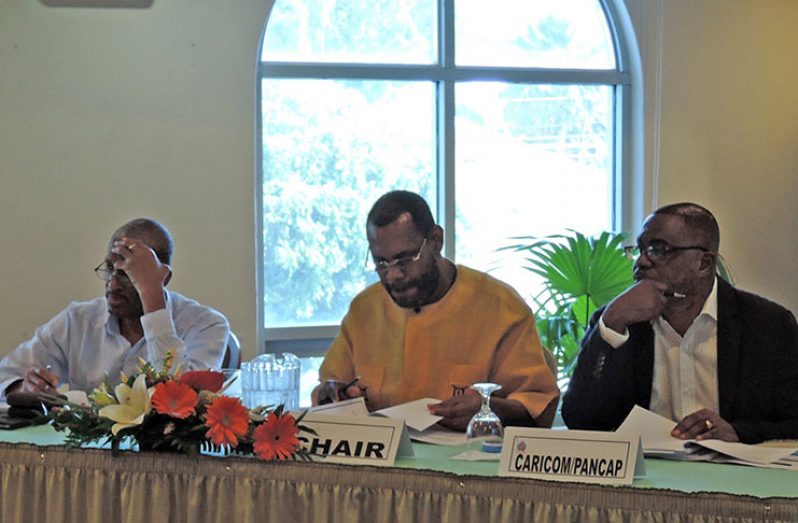— says report on Caribbean fight against HIV epidemic
ALTHOUGH the Caribbean has made progress over the years in responding to the HIV epidemic, a recent evaluation shows that the Region is not progressing fast enough to meet its 2020 targets.
In fact, the annual number of new HIV infections among adults in the Caribbean declined by only 18 per cent from 2010 to 2017, while the number of HIV-infected pregnant women receiving antiretroviral therapy (ART) has dropped.
According to UNAIDS 90-90-90 target, the Region should diagnose 90 per cent of all HIV positive people; provide ART for 90 per cent of those diagnosed and by 2020, achieve viral suppression for 90 per cent of those treated.
The research, which showed the Region’s shortcomings was conducted by the Pan Caribbean Partnership against HIV and AIDS’ (PANCAP) Priority Areas Coordinating Committee (PACC).
It saw the evaluation of the Caribbean Regional Strategic Framework on HIV and AIDS (CRSF) 2014 – 2018 and detected that the impact of the prevention response has been inadequate, particularly among key populations.
Those among the key populations are men who have sex with men (MSM); Sex Workers (SWs) and their clients; partners of key populations; transgender persons and persons who use drugs, all of which accounted for 68 per cent of the new HIV infections during this period.
One positive the body note, however, was that new infections among children fell from an estimated 2,300 in 2010, to 1,100.
Although significant progress has been made in eliminating mother-to-child transmission of HIV, for the period 2015-2017, data shows that HIV-infected pregnant women receiving ART to reduce HIV transmission declined from 92 per cent in 2014 to 79 per cent in 2015.
It declined further to 75 per cent in 2016 and 2017 respectively, illustrating a significant decrease which the PACC has determined warrants investigation.
While PANCAP noted that progress has been made regarding placing more people living with HIV on treatment, much more needs to be done, especially to retain people on treatment.
“The gap to achieving the first 90 of the 90–90–90 targets in 2017 was 54,800 people living with HIV. The gap to achieving the first and second 90s of the 90–90–90 targets in 2017 was 74,700 people living with HIV. The percentage of people living with HIV who achieved viral suppression increased from 37 per cent in 2016 to 40 per cent in 2017,” the report said.
“However, the gap to achieving all three 90s at the end of 2017 was the need for an additional 103,000 people living with HIV to be on ART and be virally suppressed. Given this situation, the Caribbean is at risk of not achieving the 2020 targets.”
LOCAL EFFORTS
While the information is generalised, Guyana has been making its own strides in this regard.
In November 2018, the Ministry of Public Health’s National AIDS Programme Secretariat (NAPS) reported that 86 per cent of all people living with HIV now know their status; 74 per cent of those diagnosed are receiving ART while 65 per cent of those on ART have achieved viral suppression.
The news was announced as the ministry launched its ‘Know Your Status’ Guyana campaign to further propel efforts to meeting the 2020 deadline.
“Clearly, you can see from this that Guyana is not too far away from achieving the first 90. However, we have a lot more work to do to achieve the second and the third 90,” said NAPS Programme Manager Dr. Rhonda Moore.
In Guyana, marginalised communities account for the most positive tests of HIV and multiple sexual partners continue to be one of greatest contributors to HIV.
According to a UNAIDS 2018 report, nearly 90 per cent of new infections in the Caribbean in 2017 occurred in four countries: Cuba, Dominican Republic, Haiti and Jamaica.
Meanwhile, 87 per cent of deaths from AIDS-related illnesses occurred in Dominican Republic, Haiti and Jamaica with Haiti alone accounting for nearly half of new HIV infections and deaths due to AIDS-related illness.
RECOMMENDATIONS
PANCAP noted that there are financial challenges to the Caribbean region which may have some correlation with the decreases experienced.
“Global financial resources to support the HIV epidemic have been progressively decreasing since 2011. However, domestic financing has improved during the implementation of the CRSF 2014-2018,” the report said.
“As at the end of 2017, domestic resources were contributing significantly to the cost of ART and the overall treatment programme. Despite this trend, national resources to support services to achieve prevention continue to be low, with the implication that the gains could be reversed if this gap is not quickly filled.”
As a result of their findings, the evaluation team proposed a number of overall recommendations for the goal as well as specific recommendations to address the gaps and challenges identified.
The team proposed the following strategic priority areas should be retained in the new CRSF: An Enabling Environment, Prevention of HIV Transmission, Treatment, Care and Support, Integrate HIV into Health and Socioeconomic Development and Sustainability.
Meanwhile, the evaluation report was accepted by the Priority Areas Coordinating Committee and the PANCAP Executive Board.
The board has now called on all countries and the partnership to renew efforts to build capacity; promote age-appropriate sexual education; introduce innovative prevention approaches; and work together to achieve the targets.



.jpg)










